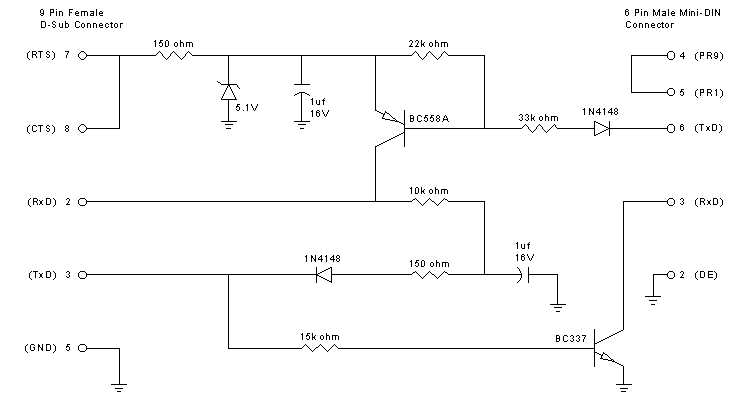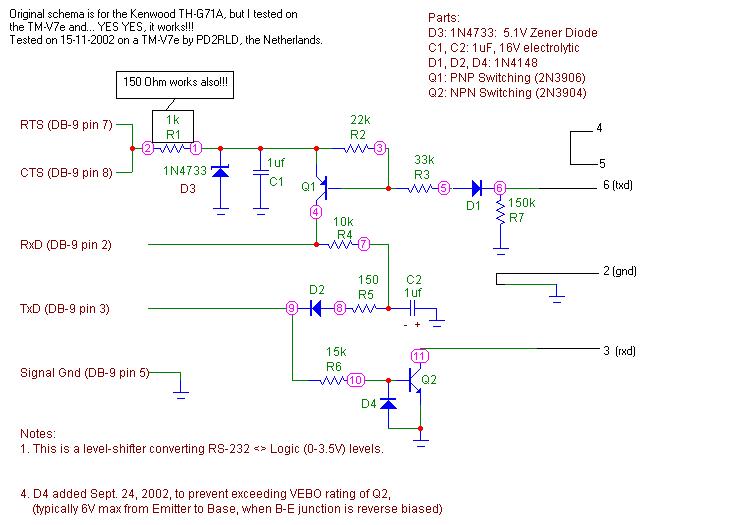PG-4S Programing Cable
This is a 'free interpretation' of DB8KY's origional German description
Found on PE1PTS' web page
An ASCII Version of this English page is available
(My notes are at the end of this page)
From the German origional:
The Kenwood TM-G707E is a wonderful rig and it's ability to name memories is a nice feature, if it could all be programed by a computer...
The software is available to anyone on the Kenwood web-site, all that's needed is the cable to connect to the computer. I have absolutly no idea what Kenwood put inside the origional PG-4S cable, however when the TM-G707E is put into Clone-Mode and you examine the signals at the Mini-DIN data port, it's clear that the cable electronics must handle TTL/RS232 conversion. The circuit described below fulfills these functions for me, with no compaints. I think the TM-V7 operates the same way.
How it works
Connecting Pins 4 and 5 tells the kenwood to switch from FSK to serial operation. The PC pulls the RxD-input on the kenwood low via R5 and T2, obviously there's an internal pull-up.
On the other hand, the connection from the Kenwood to PC is more difficult, the Kenwood offers only one TTL-Signal, the serial input on the PC, however, expects to see two levles, about 10V +/-. There must be two signals.
Via R1, a positive signal from the PC's RTS is seen and stabilized by D1 and C1. A negative voltage is achieved from the PC's TXD signal via D3 and R6 and is buffered by C2. Then the Kenwood can now send data with T1 switching between positive and negative voltages.
I stuffed the whole thing in a Sub-D connector hood.
Wulf wishes you lots of fun with it, DB8KY
Whoever uses a device made with these plans does so at their own risk.
 Schematic re-drawn by KC7KC from the origional by DB8KY - Thanks Keith!
Schematic re-drawn by KC7KC from the origional by DB8KY - Thanks Keith!
R1/R6 = 150 Ohm
R2 = 22k Ohm
R3 = 10k Ohm
R4 = 33k Ohm
R5 = 15k Ohm
C1/C2 = 1uF/16V Electrolytic
D1 = Zener Diode 5.1V
D2/D3 = 1N4148 or similar
T1 = BC558A or similar
T2 = BC337 or similar
KC7ZRU's Notes (using TM-V7A)
These are the Radio Shack Part numbers for the cable I built
R1/R6 = 271-1312 (150 Ohm)
R2 = 271-1128 (22k Ohm)
R3 = 217-1126 (10k Ohm)
R4 = 271-1129 (33k Ohm)
R5 = 271-1127 (15k Ohm)
C1/C2 = 272-996 (Non-polarized electrolytic)
D1 = 276-565A (1IN4733A 5.1-volt Zener Diode)
D2/D3 = 276-1620 (1N914 Type Diode)
T1 = 276-1604 (2N3906 - PNP Type Transistors)
T2 = 276-1617 (NPN Type switching transistors) of the venerable 2N2222 flavor
Extras
Aluminum Project enclosure - 270-235
6-Pim Mini-DIN Male Plug - 276-1474
Metalized Hood (DB-9) - 276-1513
DB-9 Female connector - 276-1538C
PC Project board - 276-0418
6-32 Rnd hd machine screws - 640-3012
6-32 Hex nuts - 640-3019
8' of 4 conductor modular phone cable. Shielded cable would be better. 3 conductors and shield on the PC side, 2 condctors and shield on the radio side.
Mini-DIN pin numbers shown in the schematic are the EXACT same as the diagram on page 80 of the TM-V7A Manual. Don't transpose them at all. If you don't have the manual, get the PDF version at the Kenwood Web site
When using the RS Mini-DIN plug, don't bother using the slip on boot. About 4 inches of black electrical tape wrapped around the plug body will hold it together and allow it to fit in the data port of the radio. Better yet, use a dead PS/2 mouse 'tail', even includes shielded cable!
Make sure the VHF/UHF chanel ratio in the software matches what your radio is set to BEFORE trying to write to the radio. I wasn't able to get my setup to delete existing information from a memory chanel. Would write new data into a memory fine, even into a memory chanel that had other data in it already. Just wouldn't replace existing info with 'null' info
NEW, IMPROVED from Roland - PD2RLD

Changes include: addition of D4 (see note 4), alternative for R1 and addition of R7
Click HERE for the complete KC7ZRU site
This English Interpretation is Copyright © 1998-2002 by Tate Belden and may not be duplicated, published or re-distributed in any form without specific written permission.
All rights reserved. Schematic drawing is Copyright © 1999-2002 by Keith Casey, copied here with permission.
Email KC7ZRU


